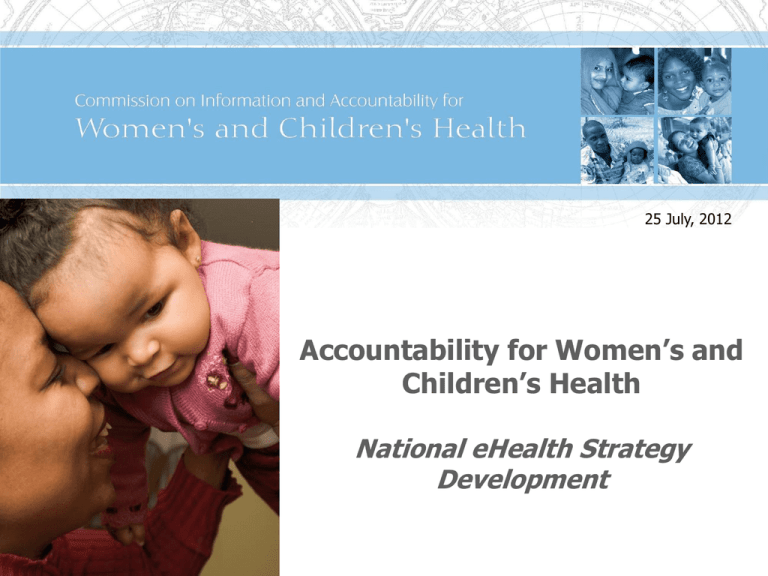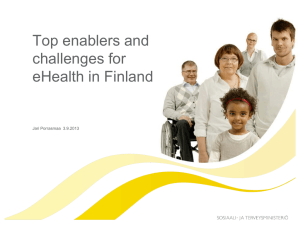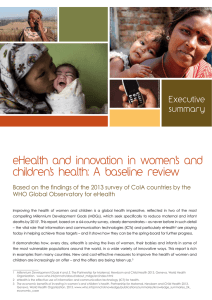Accountability for Women’s and Children’s Health National eHealth Strategy
advertisement

25 July, 2012 Accountability for Women’s and Children’s Health National eHealth Strategy Development The UN Secretary-General’s Global Strategy The aspiration: to save lives of ~16 million women and children Protect 120 million children from contracting pneumonia Prevent 88 million children from stunting Prevent 33 million unwanted pregnancies Prevent 15 million deaths of children under the age of 5 Prevent 570 thousand deaths of pregnancy related complications 2 From vision to action UN Secretary General’s Global Strategy September 2010 Commission on Information and Accountability Recommendations May 2011 Multi-Stakeholder Strategy Workplan & Budget November 2011 Concrete Actions Specific targets, priorities, activities, roles & responsibilities 3 The Commission’s 10 Recommendations Recommendations 1-3: Better information for better results Recommendations 4-6: Better tracking of resources for women's and children's health Recommendations 7-9: Better oversight of results and resources: nationally and globally Recommendation 10: independent Expert Review Group Assess progress in implementing the Global Strategy and recommendations of the Commission, reporting regularly to the UN SG 4 The iERG Independent expert group announced September 2011 – Carmen Barroso, Zulfikar Bhutta, Richard Horton, Dean Jamison, Joy Phumaphi, Marleen Temmerman, Miriam Were Core functions: Assess stakeholder commitments to Global Strategy and Commission Recommendations Track flow of resources Review progress on implementation Identify obstacles to implementing Identify good practice Make recommendations Nine working groups implementing Monitoring of resources in countries: WHO, USAID, World Bank, Gates Foundation. Monitoring of results in countries: IHP+ M&E working group Civil registration and vital statistics systems: HMN MoVE IT, Plan International, UNESCAP, UNECA etc. CDC Innovation & eHealth: Norad, ITU, mHealth Alliance, WHO, Innovation Working Group with linkages to Grand Challenges Maternal death surveillance & response: WHO, CDC, H4+, UNFPA, University Aberdeen, LSHTM, Evidence for Action. Health reviews: : IHP+, Countdown, H4+, IPU Advocacy and action: PMNCH, UN SG, UN Foundation, African Union Commission, Africa MNCH Coalition, Pan African Parliament, Africa Public Health Parliamentary Network, IPU, Countdown to 2015 Global monitoring of results: Countdown, UNICEF, WHO Global monitoring of resources: OECD/DAC, WHO 6 7 Snapshot of Progress towards recommendations Work Area Country Accountability Framework 1 Vital events Maternal death surveillance and response 2 Health Indicators 3 eHealth and Innovation 4 Resource Tracking 5 Country Compacts 6 Reaching women and children Recommendation Target Result Status Countries have plans for strengthening national accountability processes 50 countries with Country Accountability Frameworks by 2013 39 countries have draft Country Accountability Frameworks On track 50 countries with CRVS assessment and plan by 2015 50 countries making improvements in MDSR 29 countries have completed civil registration vital statistics assessment 29 countries making improvements in MDSR On track By 2012, countries using 11 indicators on RMNCH, disaggregated for gender and other equity considerations. 50 countries use and have accurate data on core indicators Global partners have streamlined reporting systems 75 priority countries have data on the core indicators GAVI, Global Fund and UNAIDS streamlining reporting system On track By 2015, countries integrating Information and Communication Technologies in national health information systems and health infrastructure. By 2015, 50 countries developed and implementing national eHealth strategies. 27 countries have a Making progress By 2015, countries are tracking and reporting: (i) total health expenditure by financing source, per capita; and (ii) total RMNCH by financing source, per capita. By 2013, 50 countries use and have accurate data on the two indicators, as part of their M&E systems. 17 countries (partially) tracking reproductive, maternal, newborn child health (RMNCH) expenditure Making progress By 2012, “compacts” in place between governments and development partners. By 2015, 50 countries have formal agreements with donors. 36 countries with compact or equivalent partnership agreement On track By 2015, governments have capacity to review health spending and relate spending to commitments, human rights, gender and equity goals and results Linked to Recommendations 2 and 4 Linked to Recommendations 2 and 4 Making progress By 2015, countries have a system for registration of births, deaths and causes of death and have health information systems 50 countries have regular national health sector reviews 7 National Oversight (Health Sector Reviews, Advocacy and Action) 8 Transparency 9 Reporting aid for women’s and children’s health 10 Global Oversight national eHealth strategy and plan 37 countries conducted an annual health sector review (in last year) On track 20 countries engaging political leaders and financial decision makers in health Parliaments from 10 countries engaged Making progress 50 countries have held a Countdown event 13 countries planning a national Countdown event Making progress By 2013, stakeholders publicly sharing information on commitments, resources and results achieved annually, at both national and international levels. 50 countries with mechanisms for sharing and disseminating data Global partners with databases on RMNCH, and disseminating core indicators Global partner databases for key 11 indicators publicly available through Countdown to 2015 By 2012, OECD-DAC to agree on improvements to Creditor Reporting System to capture RMNCH health spending by development partners. By 2012, development partners agree on method. By 2013, OECD has developed guidance and instruction to support new method and donors implementing it Members of the OECD-DAC’s Working Party on Statistics agreed to use a scoring system of five values to tag RMNCH investments in the Credit Reporting System iERG reporting to the UN Secretary-General on the results and resources Members appointed Report due September 2012 By 2012, countries have transparent and inclusive national accountability mechanisms. Making progress On track Independent Expert Review Group (iERG) members selected On track Report In progress Recommendation 3: eHealth Recommendation - Innovation: By 2015, all countries have integrated the use of ICT in their national health information systems and health infrastructure. Target: At least 50 countries have developed and are implementing national eHealth strategies, including specifics on how this benefits information and accountability for women’s and children’s health. Result: 27 countries have eHealth strategies 39 countries have draft Country Accountability Frameworks with eHealth components 9 Moving forward Expanded partnership and collaboration, i.e private sector, civil society, regional bodies Technical support for countries Financial support to complement catalytic funding for all 75 countries Communication, advocacy to keep up momentum towards commitments http://www.who.int/woman_child_accountability/en/ 10 Upcoming regional workshops: September 2012 – December 2012 September 4-6: Alexandria: 10 countries: Somalia, Djibouti, Egypt, Iraq, Morocco, Afghanistan, Pakistan, Sudan, South Sudan, Yemen. September 4-6: Guatemala City: 6 countries: Haiti, Bolivia, Brazil, Guatemala Mexico, and Peru. September 24-26: Bangkok: 6 countries: Bangladesh, Democratic People’s Republic of Korea, India, Indonesia, Myanmar, and Nepal October (tbc): Harare: 9 countries: Botswana, Eritrea, The Gambia, Lesotho, Namibia, Nigeria, Liberia, South Africa, Swaziland. October 8-10, 2012: Bishkek: 5 countries: Tajikistan, Uzbekistan, Kyrgyz Republic, Azerbaijan, Turkmenistan 11 Thank you 12


